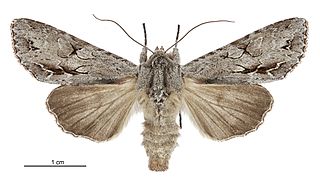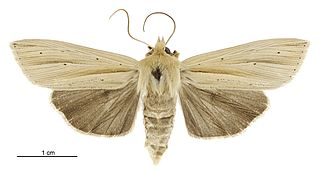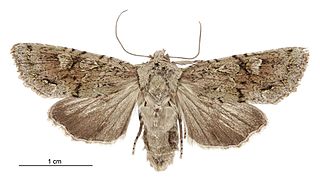
Ichneutica mutans, commonly known as the New Zealand cutworm or the grey-brown cutworm, is a moth of the family Noctuidae. This moth endemic to New Zealand and can be found throughout New Zealand, including from Three Kings Islands down to Stewart Island. However this species is not found in the Chatham Islands. The adult moths are on the wing all year round. I. mutans is variable in appearance and can be confused with similar species in the same genus. As a result of the variety of host species consumed by the larvae of the species, including such crops as turnips, wheat and apples, this species is regarded as an agricultural pest. However between the early 1960s and late 1980s the population of I. mutans was shown to have decreased significantly, by over 80%, at two study sites.

Meterana is a genus of moths of the family Noctuidae. This genus is endemic to New Zealand.

Ichneutica insignis is a moth of the family Noctuidae. It is endemic to New Zealand. This species is found throughout New Zealand, although it appears to be scarce in inland sites of tussock grasslands. The adults are on the wing throughout the year. It is a variable species and as such can be easily confused with I. skelloni and I. plena. The larvae of this species have been recorded as feeding on Trifolium pratense.

Ichneutica ustistriga is a moth of the family Noctuidae. It is endemic to New Zealand and can be found from the Three Kings Islands to Stewart Island. This species lives in a wide variety of habitats including domestic gardens, horticultural areas, orchards, native and exotic grasslands, as well as native forest. The larvae eat a variety of herbaceous plants. Recorded food plants include Muehlenbeckia australis, Muehlenbeckia complexa, Olearia hectorii, and Plantago lanceolata. This moth has a mauvish grey wing colour and is unlikely to be confused with other species as the patterns on its forewing are distinctive. This species is on the wing throughout the year and is attracted to both sugar and light traps. Adult moths can be found at rest on fences and tree trunks during the day.

Ichneutica semivittata is a moth of the family Noctuidae. It is endemic to New Zealand. It can be found from the Three King Islands down to Stewart Island. The similar species I. sulcana can be distinguished from I. semivittata as the former is much larger, has a darker hindwing and abdomen and has only one to three spots located behind the middle of the forewing in comparison to the 8 or 9 of I. semivittata. This species lives in a variety of habitats from open grasslands to clearings in forest and at a range of altitudes from the sea level to the alpine zone. Larval host species include Juncus procera, Carex secta as well as on tussock grasses such as Poa cita, P. colensoi and Festuca novae-zelandiae. Adults of this species are on the wing from August to April and are attracted to light.

Ichneutica plena is a moth of the family Noctuidae. It is endemic to New Zealand. It is widespread throughout the North, South and Stewart Islands. It is a variable in appearance and therefore can be confused with its near relatives I. peridotea and I. insignis. The larvae of I. plena feed on herbaceous plants including Fuchsia excorticata, Coprosma species, and introduced species such as garden fuchsia as well as crops such as apple trees. Adults of this species are on the wing from late August until May.

Ichneutica maya is a moth of the family Noctuidae. It is endemic to New Zealand. It is found in the mountains in southern half of the North Island and in the South Island. I. maya is a distinctively coloured and patterned moth and as such is unlikely to be confused with similar species. I. maya can be found in the southern half of the North Island down through the South Island. This species can be found in alpine to subalpine zones with high rainfall but in Southland this species can be found down to sea level. This life history in the wild is unknown, nor has its larval host species been confirmed. Adults are on the wing from December to March and are attracted to sugar and light traps.

Ichneutica morosa is a moth of the family Noctuidae. It is endemic to New Zealand and is found in the southern parts of the North Island and throughout the South Island. I. morosa is common in the eastern parts of both those islands and also in Fiordland. I. morosa can be found from altitudes ranging from lowlands to the alpine zone. I. morosa is absent from the range of its closely related species I. mustulenta, that is from the northern North Island. The larvae of I. morosa are known to feed on Poa astonii and also on other Poa species including introduced species. As well as its standard form the adult moths have a grey colour morph with the head and thorax being a grey and mottled brown, and the forewing being a pale greyish ochreous to a deep brown, suffused with grey. I. morosa can be confused with I. mustulenta and I. lignana. Adults are on the wing from November to April.

Ichneutica nullifera is a moth of the family Noctuidae. This species is endemic to New Zealand and can be found in the Tongariro National Park, along the Wellington coast and throughout the South Island. The adults are large and the forewing of adults can vary in colour from pale fawn to dark grey. The larvae are coloured a bright yellow-brown with a paler underside. The larval host species are in the genus Aciphylla and as a result the adult moths are often found in habitat dominated by species in this genus. Adults are on the wing from November to early April and are sometimes attracted to light.

Ichneutica omoplaca is a moth of the family Noctuidae. It is endemic to New Zealand. It is widespread from the Bay of Plenty in the North Island down to Southland in the South Island. Specimens have also been collected from the Auckland Islands. It lives in a variety of habitats including beech forest clearings and tussock grasslands. This species has been recorded that some of the larval hosts of this species include Poa cita, Dactylis glomerata and it has been reared on Plantago lanceolata. The larva is undescribed but pupae have been found in a pine plantation in soil under weeds. Adults of this species are on the wing from October to March. The adult moths are variable in appearance but the diagnostic feature is the pale ochreous to white colouring between the basal streak and the costa which contrasts with the ground colour of the forewing.

Ichneutica pagaia is a moth of the family Noctuidae. I. pagaia is endemic to New Zealand and can only be found on the Snares Islands. This species is unlikely to be confused with moths with a similar appearance as it is the only noctuid found in the Snares Islands. Its preferred habitat is tussock grasslands and the hosts for its larvae are likely Poa astonii and Poa tennantiana. Adults of this species are on the wing from November to February.

Ichneutica scutata is a moth of the family Noctuidae. It is endemic to New Zealand. This species can be found in the southern parts of the North Island as well as the eastern parts of the South Island. It is similar in appearance to I. insignis and I. skelloni but can be distinguished as I. scutata is much paler in appearance. It is likely this species inhabits lowland tussock grasslands as well as coastal dunes although it is not common in inland tussock grasslands. The larvae feed on a variety of herbaceous plants such as Plantago and Convolvulus species, Plagianthus divaricatus. It pupates on soil near its host plants. The adults are on the wing from late March to July.

Ichneutica atristriga is a moth of the family Noctuidae. It is endemic to New Zealand and is found through out the North, South and Stewart Islands. The larval hosts likely include tussock grasses included Poa cita, P. colensoi and Festuca novae-zelandiae. Larvae have been reared on species in the genera Bromus and Festuca. The adults of this species are on the wing from November to May. I. atristriga can possibly be confused with the smaller species I. propria. However I. atristriga has thorax and forewings that have a pinkish tinge and I. propria has a dark streak on the discal part of the forewing which I. atristriga lacks. A study has indicated that the population numbers of this species have decreased.

Ichneutica sulcana, the dark underwing wainscot, is a moth of the family Noctuidae. It is endemic to New Zealand and can be found throughout the North, South and Stewart Islands at a range of altitudes from the lowlands to the alpine zone. This species prefers to live in native grass, shrub and wetland habitats as well as in native forest. The larval host plants of this species are forest grasses and sedges and larvae have been reared on Microlaena avenacea and species within the genus Carex. The larva pupates in the soil. Adults are on the wing from December to May but have also been recorded in August and September in the northern parts of the North Island. They are attracted to sugar traps as well as to light. I. sulcana and I. supersulcana are very similar in appearance but can be distinguished as there are differences in the male abdomen and genitalia of the two species. Also these two species do not appear to share a range as I. supersulcana seems to prefer to live at higher altitudes than I. sulcana. I. sulcana might also be confused with I. semivittata but I. sulcana is a larger species with a much darker abdomen and hindwing, and has only 1 to 3 dots on the forewing postmedian line.

Ichneutica averilla is a moth of the family Noctuidae. It is endemic to New Zealand. This species is found in the North Island at Mount Taranaki but is widespread throughout the South Island and Stewart Island. It prefers mountainous habitat but can be found down to sea level in the southern parts of the South Island. Adults of the species are on the wing between November and March. Larvae likely exist on a variety of herbaceous plants but have been recorded as feeding on species within the genus Plantago. This species is sometimes confused with I. mutas but can be distinguished from the latter on the basis of forewing colour as well as the absence of or an indistinct antemedian forewing line.

Ichneutica epiastra is a moth of the family Noctuidae. It is endemic to New Zealand and is found throughout the North, South and Stewart Islands. This species prefers open habitats such as wetlands, dunes and forest clearings. Eggs are laid in the summer or autumn and larvae feed during winter and spring. The larval host species are found within the genus Austroderia. The adult moths are on the wing between October and February. Adult I. epiastra can possibly be confused with the similar species I. arotis and I. haedifrontella however there are differences in appearance that enables I. epiastra to be distinguished from these two species. In particular I. epiastra has long sharp-tipped ‘horns' on its head that are diagnostic. The adults of this species appear reluctant to be attracted to light although they do come more frequently to the brighter mercury vapour traps.

Ichneutica erebia is a moth of the family Noctuidae. This species is endemic to New Zealand and is found on Campbell Island and the Auckland Islands. Adults of this species are on the wing from August to January. The adults are variable in appearance but can be distinguished from similar species by the patters or lack thereof on their forewings. The larvae of I. erebia are polyphagous and hosts include Pleurophyllum criniferum, species within the genera Stilbocarpa and Carex, as well as Chionochloa antarctica, Urtica australis and Raukaua simplex.

Ichneutica skelloni is a moth of the family Noctuidae. This species is endemic to New Zealand. Its presence has been confirmed in the North Island only in the Wellington region but is widespread throughout the South Island. It is also found in Stewart Island. I. skelloni is extremely variable in size, in the colour and patterns on the fore and hind wings, length of pectinations on male antennae and even in its genitalia. A larger more patterned form can be found in Westland and Fiordland, a medium-sized form is found from Wellington to Stewart Island and there is also a smaller Dunedin and Southland form. This species can be confused with specimens with the species I. insignis, I. scutata and I. pelanodes. I. skelloni can be found in forest and shrubland habitat. Adults are on the wing from July to April and are attracted to light. Host plants for the larvae are found in the genera Plantago, Senecio and Ranunculus and also include the species Bellis perennis.

Ichneutica paracausta is a moth of the family Noctuidae. This species is endemic to New Zealand. It is found locally in the central North Island, is widespread in the South Island and can also be found in Stewart Island. I. paracausta is variable in colour, but as it has a distinctive black streak on its forewing as well as a wing pattern that is characteristic, I. paracausta is unlikely to be confused with other species. It is present on the North Island volcanic plateau as well as Little Bush Reserve in Hawkes Bay in the North Island as well as in tussock grassland, alpine and subalpine shrubland and in alpine forest. Larvae have been recorded as feeding on grasses, a pupa has been found in a cocoon under the bark of a tree and adult moths are on the wing from October to January.

Ichneutica infensa is a moth of the family Noctuidae. This species is endemic to New Zealand. It is found throughout the North and South Islands but appears to be rarely seen or collected in the north and west parts of the North Island. As at 2019 the northern limit to the range of this species is Titirangi. I. infensa inhabits tussock grasslands and native forest. Larvae are nocturnal and its host plants are in the genus Carex including Carex solandri. Larvae have also been raised on Bromus catharticus. Adults of this species are on the wing from late October to February. Adults are narrow winged with patterns on the forewings that are relatively distinctive. However this species can possibly be confused with I. inscripta.
























